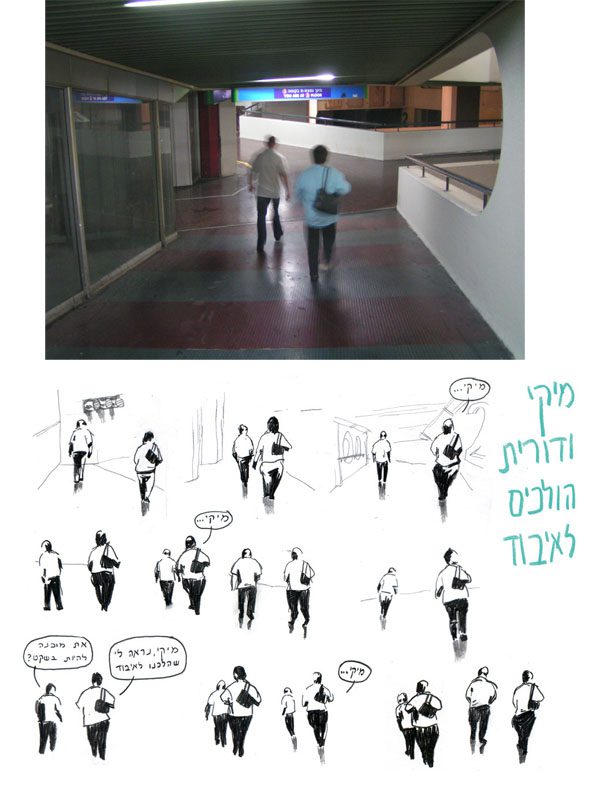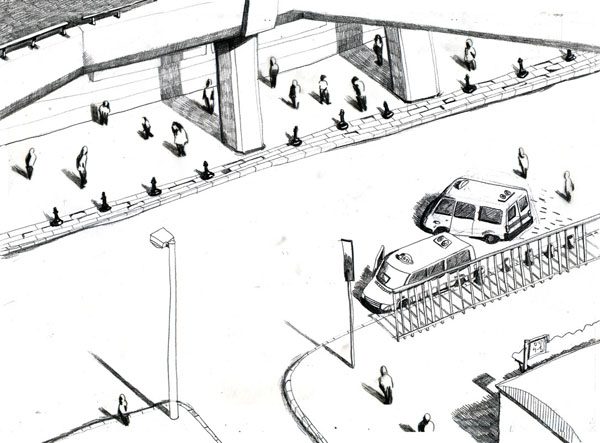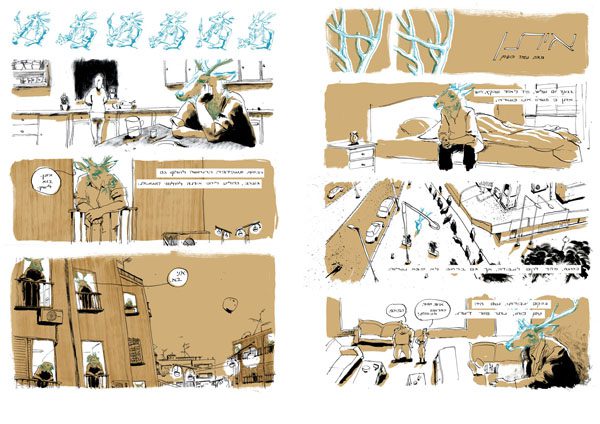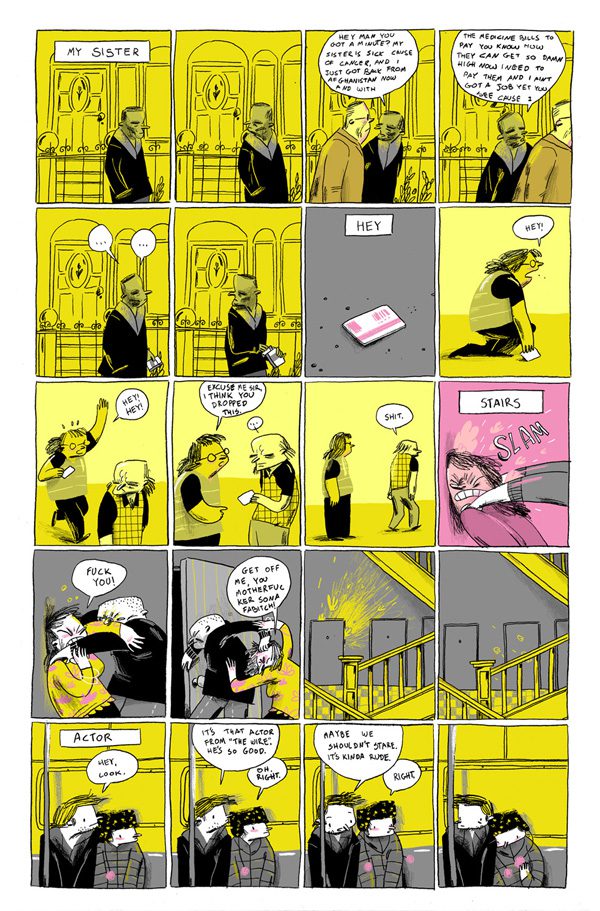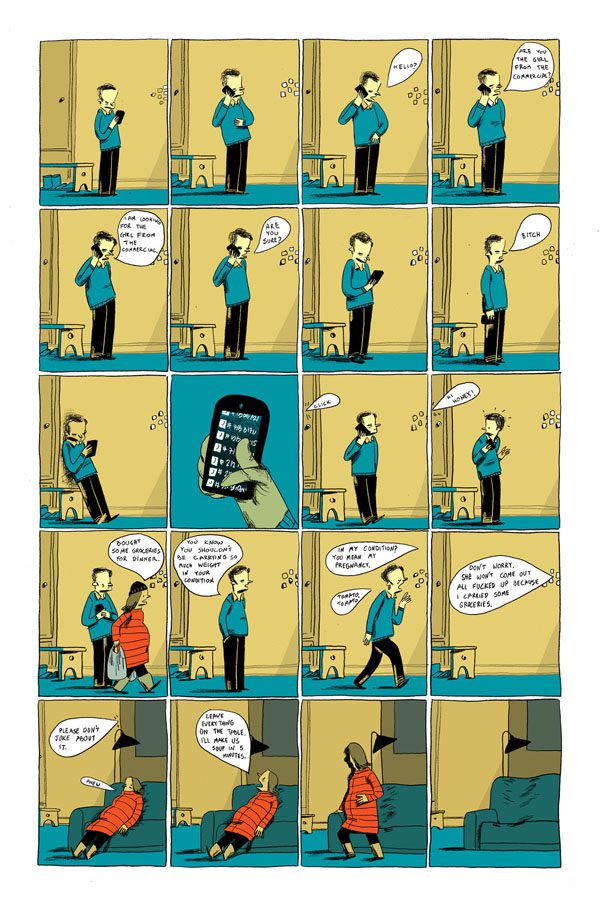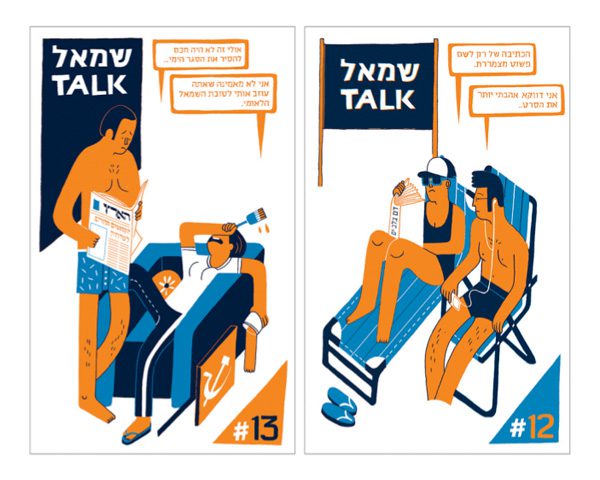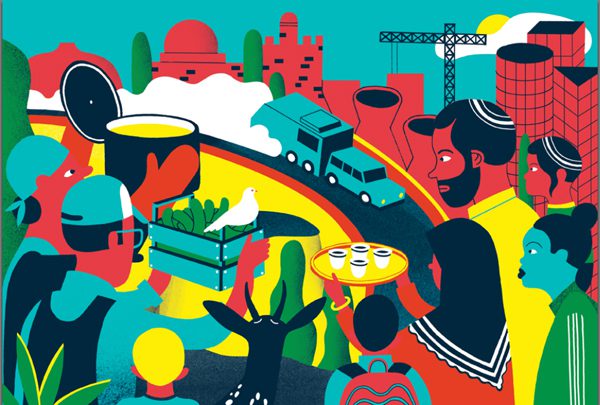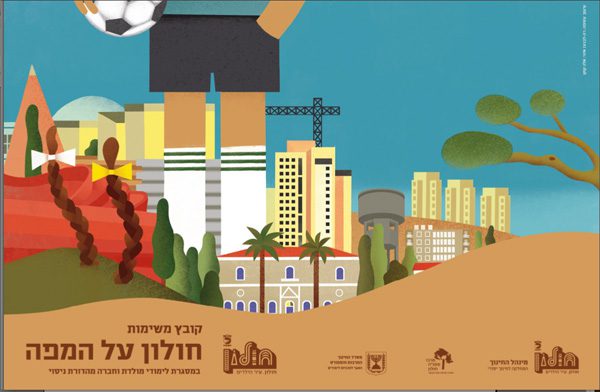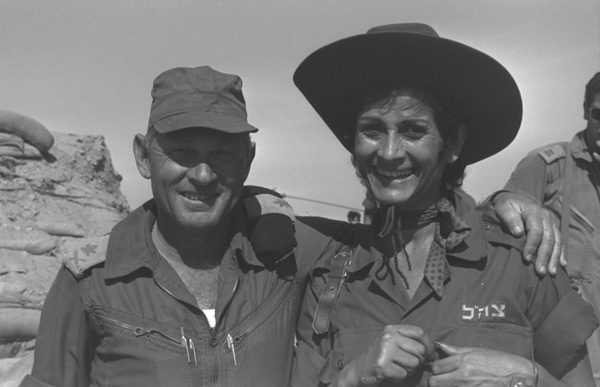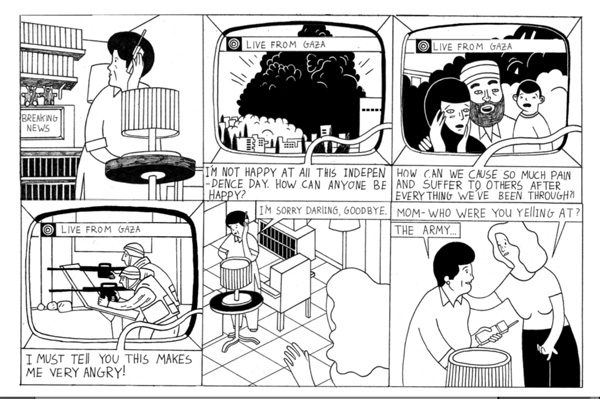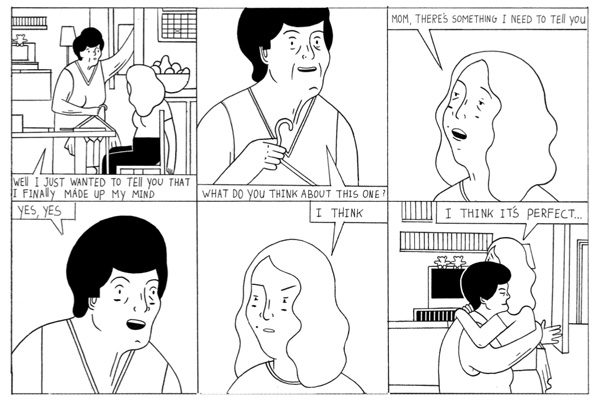The New York Comics & Picture-Story Symposium is a weekly forum for discussing the tradition and future of text/image work. Open to the public, it meets Monday nights 7-9pm EST in New York City. Presentations vary weekly and include everything from historical topics and technical demonstrations to creators presenting their work. Check out upcoming meetings here.
On separate occasions, over the recent months, The Comics Symposium has hosted two Israeli cartoonists, both graduates of the Bezalel Academy for Art and Design. As their stories share glimpses of the same Israeli landscape and especially of the Tel Aviv Central Station, I thought it would be interesting to document their presentations as two passengers crossing paths in the same two-part article.
Omer Hoffmann is a freelance illustrator based in Brooklyn, New York. His work includes: editorial illustration, storyboards, animation, children’s books and comics, and he uses a wide scope of mediums and styles accordingly. He creates a monthly column about his life in New York for “The Israeli Museum of Caricature and Comics” in Holon and in the past had a regular column in “Hatzofar”, a monthly independent free comics magazine. He also contributed comics to children’s magazines and various publications.
 Hoffmann opened with his contribution to the anthology “Based on a Real City” on which he collaborated with six of his classmates, right after college. “Based on a Real City” consists of six comics stories, each concentrating on a particular physical feature of Tel Aviv ( a certain building, neighborhood, the beach etc).
Hoffmann opened with his contribution to the anthology “Based on a Real City” on which he collaborated with six of his classmates, right after college. “Based on a Real City” consists of six comics stories, each concentrating on a particular physical feature of Tel Aviv ( a certain building, neighborhood, the beach etc).
“Mickey and Dorit getting lost”
Hoffmann said, “We were all still infused with the creative spirit reserved for students, we wished to create a platform where we will be able to voice our ideas. A comics book seemed such a natural solution to us, I often wonder why, as only half of the six creators ever drew one before.
A year later we published a second anthology titled “2”. Our creative process resembled our own experience from the academy, where one would bring forth work he had done, and the rest would discuss it, compare ideas and suggest alternate solutions. Since the group was sort of an extension to our days as students, we were naturally inclined to create work leaning towards the atmospheric, bizarre and experimental.”
“A Bird Boards A Bus”
“George, Sandra, Su-Chin, Magna, Stefan and Adriana on the phone”
Hoffmann went on to demonstrate how the architectural elements of his object of choice; Tel-Aviv’s Central Station, inspired his poetic short stories in “Nothing Comes Out of the Pipes”. He isolates moments from the cacophony of colors, languages, cultures, stores, stairways, corridors, trapping the herds of people that move through it, more so than actually leading them to a place they need to get to. One would get lost more often than one would ever arrive anywhere.
“Olga Recalls the First Snow in Minsk”
Hoffmann created “No Recalling, No Forgetting” for the second anthology. It is based loosely on real events. While sitting in a Cafe, he watched as two policemen were trying to help a lost elderly woman recall her address. Apparently, she left her house without her purse or any documents of identification. She insisted her address was in Poland and she was living with her brother. This gave him the idea for a story about an old woman whose sense of reality constantly collapses while her memories resurface to fill its place. Hoffmann said “Some parts of it, particularly the more optimistic flowery scene, I felt conveyed the sort of wonderment with an underlying sense of horror and sadness I was experiencing when I had witnessed the scene.”
Regarding the themes of these projects, I asked Hoffmann whether there was something in his way of storytelling that defines him as an Israeli comics artist. In reply, he answers “I’m not so sure anything defines my art as Israeli. It’s not a goal I strive for, nor is it for many native comics artists. Especially given the sorry state of the comics market in Israel. It’s more of a given fact – I create here and this is the visual and emotional information I can use. Settings are very important to me, so any drawn space, both exterior or interior, has to have its own special feeling and contain that certain ingredient that enhances the story and gives it perspective. Sometimes, a certain rhythm needs recreating. Tel-Aviv in that way is an amazing resource, with its ugly roofs full of useless antennas and boilers, hard building angles, all dotted with black, thick wires dangling, and boxed A/C. It’s a goldmine. Thank heavens for small miracles.”
Those Tel-Avivian treasures are very prominent in Hoffmann’s comics “Eitan” 2008. Eitan, (a word also meaning strong/firm in Hebrew) wakes up one day feeling not quite himself. Unable to settle his mind by performing the tasks of his work which would normally invigorate him, he chalks this feeling up to the changing of the seasons. The strip ends as he is beckoned back inside from the balcony by his wife.
Hoffmann’s work as an illustrator has affected the look and sensibilities of his comics. When he first began illustrating children’s books, he employed a new style that would quickly become the dominant one he uses for comics ever since.
Although his newly acquired style may have taken over all the various venues for his work, comics will always be a platform for his own point of view to emerge. This is not often the case with commercial art. He stated that “more generally, my work can be defined as a reaction to my creative process . Usually, when I start working on a new piece or an idea in any medium, I unconsciously try to find its reflection; a negative twin. So when creating an editorial illustration driven by a solid idea, I quickly react and create comics without any meaning. Therefore, my comics are varied in style and tone. As a result of working in commercial arts, a lot of my comics have little purpose or meaning except their own existence. I believe this is somehow driven by a sense of loss of the road not taken, so maybe my comics are fragments of a person I could have been or wish to be.”

I asked Hoffmann if he had a preference of subject matter, be it surreal, poetic or humorous.
“I wish there was a clear-cut answer. It all depends on several factors. In general, I like to create comics and stories that leave room for the reader to fill in the blank, much like an unfinished sketch or an opening scene from a movie. One thing can be said for certain – whenever I have more time, serious stories emerge. But when confronted with tight deadlines, I create humorous work….I view the layout as an integral part of the story. Sometimes, the story grows with the layout together. So by playing with the story and the layout I can edit and re-edit until I have a sense of the perfect flow. This actually is probably the only ingredient all my works have in common, striving for that rhythm that “plays” right and looks right at the same time…
“Most of my ideas arrive when I let my thoughts just wander around and associating things I hear or see around me with my personal views. For example ,my last comics page idea originated from a commercial poster I saw in the subway of a perfect American couple washing a car, which triggered me to think of the role the models have in shaping people’s intimate views. Sometimes it’s not easy though, and I have to find a bunch of ideas and just hammer them together into a solid concept. That often leads to the worst of days and to drinking way too much coffee.”
Ella (Kookoo) Cohen, a freelance illustrator based in Tel-Aviv, emphasized the local aspects of her work in her presentation. Her senior thesis project at Bezalel Academy was a proposal for a daily single-panel comics column in the opinion pages of “Haaretz”, the leading left-wing newspaper in Israel. She titled her project “Small Talk”, a whimsical play on the dual meaning of “small”, meaning left-wing in Hebrew. Her duo-chromatic panels featured short, ironically understated dialogues in (almost silly) rhyme between young, privileged left-wingers who talk about the horrific current events padding them in print on either side rather than acting on them. Cohen listed the particularly dramatic events of her graduate year, 2010, which compelled her to create something with a political statement.
The details and specificity of the Israeli urban landscape are in abundance in Cohen’s illustrations. The symposium crowd pointed out the sea of cranes that seam to dominate grid in her compositions. Cohen agreed with this observation, saying that the landscape is in constant mode of change and construction. There is a tension between the temporary sense of the present and the unknown future.
The value she places on creating illustration that reflects on the local culture was the incentive behind the project she initiated “Hagirsa.com”, i.e “The Illustrated Version”. Cohen approached twenty or so young illustrators and asked them to pick a previously un-illuminated Hebrew literary text and upload illustrations for them on a monthly rotation. The result was a contemporary and fresh interpretation of literary treasures attracting a new generation of readers to long forgotten masterpieces.
Cohen was commissioned by the “Outbox” organization to create a notebook design representing her view of Tel Aviv. She chose to illustrate the polar ends of Tel Aviv’s transportation arteries, the filthy micro cosmos of the Tel Aviv Central Bus Station, and the sterile, serene platforms in the city’s north.

She concluded the presentation with her latest comics for Scrawl Magazine’s “Power” issue, “The Songstress of the wars”. Yaffa Yarkoni was a singer who rose to diva status in the first decades of Israel’s independence. She uplifted spirits amongst the ranks of the IDF and represented Israel on stages world wide with songs and lyrics revolving the beauty of the Israeli landscapes. She was given her aforementioned title due to her fearless ventures into the front lines to sing to the troops. However, she preferred being called the songstress of the soldiers and rejected her moniker. Her personal views inclined towards left-wing Zionism.
The last couple of years of her life ended on a tragic note. While diagnosed with Alzheimer’s; she was interviewed on the radio and protested against the immoral acts of the soldiers. Her words were interpreted by the media to be a blunt comparison between the occupation of Palestinian territories to the Holocaust. As a result of the pressure from the protesting right-wingers, a celebratory evening paying tribute to her life’s work was cancelled.
The bittersweet ending of Cohen’s comics resonated with Hoffman’s “No Recalling, No Forgetting” and his Polish immigrant protagonist who is trapped between her memories and reality. Ultimately for better or worse, it is the national collective subconscious, which makes her jumbled and fragmented stories familiar to those listening and reaching out to help her. In Cohen’s story, her daughter shields her by letting her remain in her own mind.
Cohen brought examples of her collaborations with fellow classmates forming the “Schwedenbitter” collective. The xeroxed anthologies are made up of bits and pieces from their school assignments. Also attached are wordless mini comics by each of members. Cohen depicted her childhood memory of her school in Haifa, portraying herself as a camel. “I like the slow, careful, nobility in their movements.” In her story, the camel seeks to escape the competitive rigid environment of the school, wondering if it represents the real world. It slowly finds its way into the open.
***
First image: Omer Hoffmann, “We Don’t Do Cool Things”, 2012
Images 2-6: Omer Hoffmann, “Nothing Comes Out of the Pipes”, 2008
Images 7-8: Omer Hoffmann ”No Recalling, No forgetting” , 2009
Image 10: Omer Hoffmann “Eitan”, 2008
Image 11: Omer Hoffmann “Father Ate Porridge”, 2010
Image 12: Omer Hoffman, 2013
Image 13: Omer Hoffmann, “We Don’t Do Cool Things”, 2012
Image 14: Omer Hoffman, “Hey -Look” 2013
Image 15: Omer Hoffman, “Hi Honey”, 2013
Image 16-17: Ella Cohen, “Small Talk”, 2010
Image 18: Ella Cohen, 2012
Image 19: Ella Cohen, 2012
Image 20: Ella Cohen, “Recession’s Slut” 2011
Image 21: Ella Cohen, “OutBox Notebook” 2011
Image 22-26: Ella Cohen, “Songstress of the Wars”, 2012
Image 27: Ella Cohen, 2010
***
About the author: Keren Katz is the illustrating half of The Katz Sisters duo. She is also the half that is not fictitious. They are currently collaborating on the graphic novel “The Night Poetry Class in Room 1001”. Check out more her projects here, and more of her books here.

